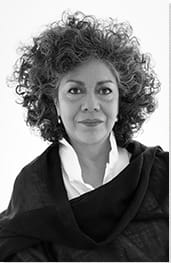Summary of Doris Salcedo
For decades, Colombian artist Doris Salcedo has been at the forefront of artmaking that seeks to provide space for mourning, grieving, and memory. Working directly with families of victims in collecting testimony and remembrances, Salcedo has taken on the task of investigating violence in Colombia and beyond, interpreting these experiences and translating them into abstracted yet impactful visual forms.
Accomplishments
- Working within sculpture and installation, Salcedo found a new way to insert and present the power of silence and absence in a medium known for materiality and monumentality. At the same time, Salcedo has been praised by critics for her evocative use of a wide variety of materials, from wood to rose petals and surgical threads.
- Salcedo's use of utilitarian objects, such as a blouse or a pair of shoes, builds on the legacy of Marcel Duchamp's "readymades". However, she has shown how everyday objects can contain within them stories and powerful emotional resonance, especially with regards to questions of gender.
- Salcedo's work provides a unique and ethical visual language for addressing violence and trauma. As she pointed out, she does not seek to reenact or represent violence (which is a more common route that other artists may take). Rather, the main concern of her work is to give voice to the voiceless since "violence silences."Based in Colombia and exhibiting internationally, Salcedo makes work that speaks to the conditions of living in the Global South, providing a representative voice for an under-represented part of the art world.
The Life of Doris Salcedo
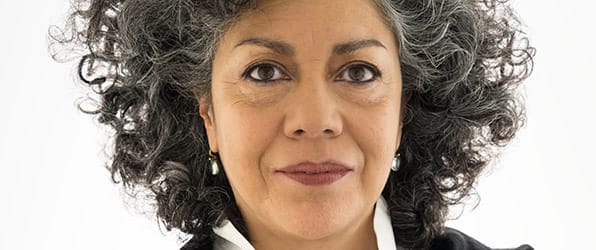
Doris Salcedo considers herself "a third world artist." Her life experiences, and ongoing research into marginalized and victimized people in her home country, put her in a position to speak "from the perspective of the victim, from the perspective of the defeated people."
Important Art by Doris Salcedo
La Casa Viuda (Widowed House) IV
This work comes from Salcedo's early series, Widowed House (1992-95). The sculptural installation consists of a door with bedposts on either side. Attached to the door near the middle are an almost translucent woman's blouse and a slender human bone. Other works in the series incorporate children's items, such as a crib, baby carriage, and bicycle seats. The series was developed after the artist had spent several months visiting family members of disappeared Colombians and talking with them about their experiences and their grief. Salcedo recalled, "One woman told me that she was afraid of Alzheimer's because she would forget her son. It's a mourning that is happening daily even after the media attention has disappeared - these parents have breakfast alone, they eat lunch alone, they have to live in an empty house and force themselves to work and try to forget despite this relentless pain." The unresolved grief and publicly forgotten trauma motivated Salcedo to make work that would commemorate such loss.
In Widowed House, the allusion to violence occurs in a subtle way through the creation of an evocatively haunting domestic scene, that of a home devoid of human occupants. The worn out woman's blouse in this work points to the existence of its former wearer, who now may exist only as a ghost, a perception that the human bone heightens, while the shape of the door frame itself suggests an anthropomorphic reading. As the artist states, "I believe that the major possibilities of art are not in showing the spectacle of violence but instead in hiding it. It is the proximity, the latency of violence that interests me."
The use of an empty wooden frame has a well-known precedent in modern art, namely Marcel Duchamp's use of it in Fresh Widow, 1920, the title of which also refers to loss, in the case the many women who became widows in the aftermath of World War I (it is also a pun on "French windows," which the work resembles). In her discussion of Salcedo's use of found objects, art curator Helen Molesworth referred to Duchamp's influential concept of the readymade (a mass manufactured object chosen by the artist to present as art). Unlike Duchamp, Salcedo's use of found objects carries an emotional charge that can also, argues Molesworth, be situated within the representation of gendered spaces and objects in art, from Judy Chicago and Miriam Schapiro's Womanhouse (1972) to Mary Kelly's Post-Partum Document (1976).
Wood, fabric, and bones - Museum of Modern Art, New York
Defiant (Atrabiliarios)
For this installation, Salcedo collected shoes that belonged to individuals (mostly women) who "disappeared" in Colombia, developing relationships with the victims' families in the process. She then placed the shoes in niches in a wall, and covered the openings with a thin layer of animal skin, which was crudely stitched to the wall with medical suture threads. The decision to present the shoes of the disappeared came from her research when, according to Museum of Contemporary Art Chicago, Salcedo "learned that female victims were treated with particular cruelty and that shoes were often used to identify remains." From talking to families, furthermore, she learned that their unresolved mourning processes almost always involved the keeping of personal items that had belonged to the disappeared. For the artist, the shoes represent the memory of the specific individuals who once wore them, the uncertainty of their fates, as well as the sense of loss and trauma experienced by their families. "The once-lived-in shoes offer a metaphor for the body's absence," she said. In her book on Salcedo, art historian Mieke Bal argues that Atrabiliarios works by "affective contagion." Because it does not provide clear-cut identification and meanings, the work "confounds" at first but may lead to political potential, argues Bal, through the viewer's "projective identification" into the work leading to empathy with the former owners of the shoes.
The title, Atrabiliarios, connotes an irritable, intemperate, or even violent personality, and derives from the Latin aura bilis, which refers to the melancholy associated with mourning. The installation format of showing similar objects in a row harkens to the theme of seriality and repetition in Pop Art (such as Andy Warhol's silkscreens), but here it is used for a deeper affective charge. In a row, the encased shoes suggest a sense of mass death. But it also offers an opportunity to acknowledge it. Salcedo notes, "In the moment that the viewer gives the work a moment of silent contemplation, only in this moment, the affective relation takes place [...] Art has an enormous power: the power to return control to life, the control over humanity, the life that has been desecrated."
Drywall, shoes, cow bladder, and surgical thread - Institute of Contemporary Art, Boston
Istanbul
For this installation, presented at the 8th International Istanbul Biennial, Salcedo precariously stacked 1550 chairs between two buildings (one of them the Palace of Justice) in central Istanbul, in order to create what she calls "a topography of war." For the artist, the chairs, which were haphazardly thrown together, symbolize mass graves, anonymous victims, and "both chaos and absence, two effects of wartime violence." Art historian and writer Ben Street notes that the chairs are all stylistically different from one another, which allows them to evoke a variety of spaces, identities, and experiences.
Although Salcedo intended for the work to represent "war in general and not a specific historical event," the site-specificity of the original installation is significant. She explains that "I was visiting the city, and [...] there were so many ruins in the central area that I started wondering, 'It doesn't make sense, that busy area has so many abandoned buildings.' They were legacies of the violent past, where Jews and Greeks were forced out of their buildings." Art historian Doris Maria-Reina Bravo asserts that "The breathtaking sight of this nearly three-story sculpture highlighted how warfare disrupts everyday life and creates refugees out of ordinary citizens as it recalls the countless shoes discovered at concentration camps at the end of World War II."
This work can be considered an iteration of her earlier piece, Noviembre 6 y 7 (2002), in which 280 wooden chairs were lowered from the roof of the Palace of Justice in Bogotá. The piece commemorated the 17th anniversary of the siege of the Palace (and the massacre in its aftermath), which she had witnessed in 1985. The art historian Mechtild Widrich coined the term "performative monument" to describe such a work, in which commemoration can be durational and transient, departing from the tradition of permanent monumentality in Western art. In a related manner, Istanbul speaks from the power of precariousness and absence as much as it impresses upon the viewer with its scale.
1,550 wooden chairs - Istanbul
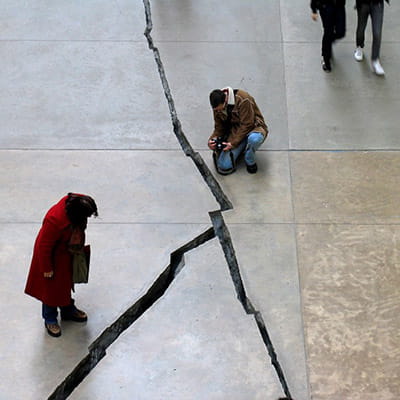
Shibboleth
Salcedo's best known work, Shibboleth was installed in 2007 in Turbine Hall at the invitation of London's Tate Modern. Although Turbine Hall had hosted some of the most significant and pioneering works by leading contemporary artists, such as Olafur Eliasson's The Weather Project (2003) and Bruce Nauman's Raw Materials (2004-05), this installation marked the first time that an artist actually altered the physical structure of the space. The piece was a 167-meter (548 foot) crack that ran along the floor of the vast hall where visitors enter the museum.
Arts research editor Celia White explains that "The term 'shibboleth' refers to a word, phrase or custom that can be used to test whether or not an individual belongs to a particular group or region. [...] With this in mind, the crack in the floor [...] could be seen as a symbol of the damage caused by cultural and geographical exclusion." For Salcedo, this dramatic crevice at the heart of the museum represents the "brokenness and separateness of post-colonial cultures," including her homeland of Colombia. In conceiving of the piece as a Colombian artist, Salcedo wanted it to speak to how "the history of racism runs parallel to the history of modernity and is its untold dark side." She said, "I wanted this crack to break the building and intrude [...] almost the same way a nonwhite immigrant intrudes in the sameness and consensus of white society."
It is worth noting that Shibboleth came about through a prestigious commission by one of the world's major art museums in a country with a long history of colonial violence. Salcedo's crack, furthermore, ran through the heart of the physical building that is steeped in the Western modern architecture lexicon. Salcedo asserted that the work was intended to reference a "colonial and imperial history [that] has been disregarded, marginalized or simply obliterated." Shibboleth, then, can be understood as a reflection on the historically exclusionary practices of Western art institutions, particularly in terms of their relegation of non-White, non-Western art objects to the domain of the "Oriental" and/or the "primitive."
The work adds to the history of sculpture and installation after Minimalism and Post-Minimalism, in which the conditions of viewing such as the space of the exhibition, as well as the viewer's body, are implicated and heightened as an aesthetic and embodied experience. Shibboleth activates this involvement of the viewer's body through its scale as well as the suggestion of potential danger, creating an art-viewing experience that compels the viewer to look close and become especially conscious of their bodies and their movement in space.
Installation - Tate Modern, London, England
Plegaria Muda (Silent Prayer)
This installation takes the form of a series of sculptures, each composed of two tables handcrafted to have the same approximate dimensions as a coffin, with one overturned atop the other. Between the tables, Salcedo laid a layer of an earth-like mineral compound, into which she planted grass. The work was conceived as a "comment on the relationships between the perpetrators of gang violence and their victims," said Salcedo. She intended the table arrangement to reference mass graves in Colombia, where many victims of gang violence are buried (For the work, she had also researched gang violence in the ghettoes of Los Angeles).
The upturned tables serve as a metaphor for the potential role reversal between killer and victim. She explained: "I focused my attention on [...] the unclear relation that has been established between the part of the victim and the killer, parts that can be exchanged by amazing simplicity. After reflecting this thoughts, I realized that this perverse and fluid exchange was possible because both (victim and killer) were living in an indefinite zone, which some people call 'social death or death in life'". Salcedo concluded, "The only way [these victims] can exist is within us in the process of living out our grief."
When asked what art is for in an interview, Salcedo said: "[it] is a way of allowing people to express what violence impelled them to do. Violence is a way of silencing." Although, as the title suggests, this work stages a ground for silent prayer, its presence gives a visual language and literal space to acknowledge violence. As days passed, the grass gradually rose through the gaps between the tables' wooden planks. It symbolizes the artist's hope that "life might prevail, even in difficult conditions."
Wood, mineral compound, metal, and grass - SFMOMA, San Francisco, California
A Flor de Piel
Made up of 250,000 rose petals sutured together by hand into a shroud, A Flor de Piel is a striking artwork that takes up space while also embodying vulnerability. Although fragile, the petals used for the piece had been treated and preserved to prevent wilting. The process, according to Museum of Contemporary Art Chicago, suspended the petals in a state between life and death. Such a material condition aligns with Salcedo's aesthetic of "visually recapitulat[ing] the unresolved nature" of her subject, as curator Madeleine Grynsztejn puts it. In this case, the subject is a Colombian nurse who was kidnapped and tortured to death, whose dismembered body had never been found. The piece "started with the simple intention of making a flower offering," said Salcedo, "in an attempt to perform the funerary ritual that was denied to her." The beauty of the piece symbolizes the beauty of a life that used to live.
The title of the piece, which translates literally as "like the flower of skin," is a Spanish expression meaning to be on edge or overcome with emotion (such as by "a sensation so overwhelming that it is expressed physically through a coloring of the body's surface," explains the Guggenheim).
In a more recent reflection on the piece, Salcedo has also noted the importance of her subject position as a South American artist. A Flor de Piel resulted from a painstaking labor process that, as the artist notes, bordered on the absurd. But the labor of the Global South (and the attendant wage inequality), Salcedo points out, is central to the contemporary world economy. The piece, she says, "mark[s] that I'm making work in the Global South."
Rose petals and thread, photograph from a 2015 installation at Hiroshima City Museum of Contemporary Art
Sumando Ausencias
In this participatory public project, Salcedo, along with hundreds of volunteers, spent six days in Bogotá's main square, stitching together 1900 pieces of white cloth. The title of the work translates roughly as "adding up absences." The work was created in collaboration with Colombia's Museo de la Universidad Nacional. Each cloth was meant to represent a death shroud. On each piece of cloth, the name of a different person, all victims of Colombia's civil war, was written in ash. Although the piece covered almost the entirety of Plaza Bolivar, which measured about 150,000 sq.ft., the 1900 names represented made up less than 7% of the total number of victims of the conflict.
Art writer and curator Madeline Murphy Turner explains that this work was inspired by a referendum that took place earlier in 2016, in which the Colombian people "narrowly voted against peace agreements that would have ended the decades-long conflict." Curator Kelly Carmichael points out that "Peace was only denied to the people of Colombia by a margin of only half a percentage point," and that "public reaction was that of horror, many felt it was a devastating missed opportunity."
Salcedo has said that she does not consider her work as activism, but sees her role as a "critical eye" for society. While not engaging directly with the referendum or its results, Salcedo's work serves as a reminder of the civil war's vast toll. "The names are poorly written, almost erased," she explains, "because we are already forgetting these violent deaths." She asserts that, "the important task for an artist here is to try to give society tools of mourning. [...] Art cannot explain things, but at least art can expose them."
The location of the work adds further meaning to it. Plaza Bolivar is an important and symbolic site in Colombia's history; many public demonstrations and protests have also been held there.
Carmichael writes that Sumando Ausencias, "instigated by the artist but created by the people of Bogatá, [...] encapsulated their emotion while making space for memory, and recognition of lives lost and peace denied."
Cloth and ash - Plaza Bolivar, Bogotá, Colombia
Biography of Doris Salcedo
Early Childhood and Personal Life
Very little is known of Doris Salcedo's childhood or personal life. She keeps these matters private, and very rarely talks about them in interviews, preferring to keep the focus on her art. As she puts it, "my work needs to speak on its own." Because of this, art historian María Alexandra Cabrera has called her "the master of silence."
ChiWhat we can tell is that Salcedo's calling to be an artist had existed since a young age and that the experience of growing up in war-torn Colombia was formative (The Colombian Civil War, a recurrent subject in her work, lasted from approximately 1948 to 2016). Of her desire to become an artist, she said, "I cannot name a date when that came to me; it has always been there." She later reflected on how everyday experience shaped her art: "Living [...] in a country at war means that war does not give you the possibility of distance," she said, "War engulfs reality completely. [...] It throws a shadow over your entire life." ldhood_text
Education and Early Career
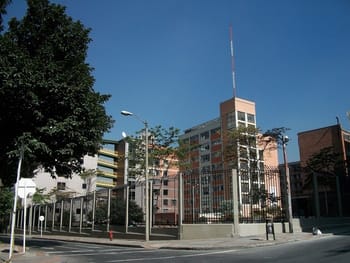
In 1980, Salcedo earned a Bachelor of Fine Arts from Jorge Tadeo Lozano University in Bogotá, where she studied painting and theatre. Her most influential teacher there was Colombian artist Beatriz González, who often incorporates found objects (such as furniture) in her work, something Salcedo would adopt in her own practice. From González, she absorbed the idea that "art does not come from imagination, but reality" and that research was an important component of artmaking. During her undergraduate years, Salcedo became involved in theater and performance and even worked for a time designing stage sets. She noted that "it was in the Colombian theatre of that time, with its political overtones, that my interests in art and politics came together."
Looking back on her art education in Colombia, Salcedo reflected that "it took place on the fringes," at a time when the country was "largely cut off from the rest of the world." However, such a condition led to a deep desire to study and make "connections with the world outside." "Paradoxically," she remarked, "one can end up gaining access to information and achieving quite a sophisticated education."
An early encounter with the work of Francisco Goya through reproductions in Colombia and then in person during a trip to Europe left a lasting impact on her. "Goya is present in all of my work," she said in a 2021 interview. It was through Goya's work that Salcedo realized the power of art to "[look] in the face of horrors," referring to Goya's empathetic depictions of political violence and executions in his own time.
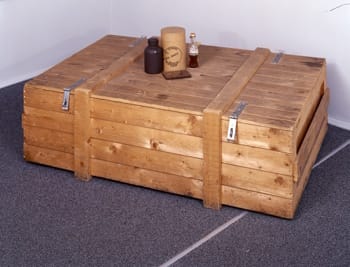
After her undergraduate degree, Salcedo relocated to New York and, in 1984, earned a Master of Fine Arts from New York University (with the support of an Icetex scholarship for international studies from the Colombian government). In New York, she became enamored with Joseph Beuys's sculptural works, which turned utilitarian objects into artworks imbued with sociopolitical meanings. She said, "I found the possibility of integrating my political awareness with sculpture. I discovered how materials have the capacity to convey specific meaning."
In the US, Salcedo reflected, "another important experience was coming to terms with being a foreigner. What does it mean to be a foreigner? What does it mean to be displaced?" After her studies, she returned to Bogotá. She said that "When I returned to Colombia, I continued to live like an outsider because this gave me the distance that one needs to be critical of the society to which one belongs." Salcedo became a professor at the Universidad Nacional de Colombia, where she taught sculpture and art theory as she steadily built her career as an artist and teacher.
On November 6, 1985, while leaving from a nearby library, Salcedo witnessed the Palace of Justice siege in Bogotá, when members of the M-19 guerrilla group took the Supreme Court of Colombia hostage, and set fire to hundreds of documents, leading to the building itself catching fire. The takeover resulted in military intervention, the (still unsolved) disappearance of a dozen people, and the deaths of over 100 people, including twelve magistrates and five M-19 leaders, as well as cafeteria workers, and some still-unidentified bodies. Salcedo recalled, "I am not left with just a visual memory, but a terrible memory of the smell of the burning building with human beings inside. It left its mark on me." The experience strengthened Salcedo's resolve to find a means of helping to make stories of victims known.
Mature Period
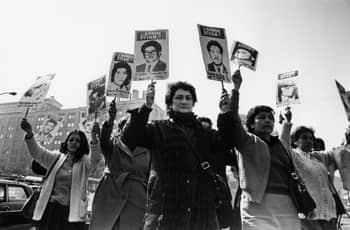
With her desire to give space for the silenced, Salcedo developed a "spare and potent" sculptural language, as art critic Ben Luke puts it. In an early, untitled work, she encased white shirts in plaster and used steel rebars to pierce through them. The work referred to the massacre of workers at two banana plantations in 1988, although Salcedo intended it to be read metaphorically for a broader resonance as well. Such a format of encased everyday objects shown in repetition, with allusions to violence through their modifications, would become a base format for her mature works.
Since the late 1980s, Salcedo has traveled around Colombia visiting abandoned villages, execution sites, concentration camps, and mass graves. During these trips, she interviews relatives of individuals who "disappeared," presumably at the hands of the military when the country was embroiled in an ongoing civil war, as well as the government's war on drugs. Salcedo explains that she tries to "be as close to [her subjects] as possible." "I try to learn absolutely everything about their lives, their trajectories, as if I were a detective piecing together the scene of a crime," she says. Through the process she develops a deep empathy that she translates into visual form: "I can't really describe what happens to me because it's not rational: in a way, I become that person, there is a process of substitution. Their suffering becomes mine." According to Tate Modern, much of her work deals with the fact that, while the death of a loved one can be mourned, their disappearance leaves an unbearable emptiness. Her work deals with not only the question of mourning, but, as she said, "an inability to mourn."
Salcedo has received many honors and awards throughout her career, including a Solomon R. Guggenheim Foundation Grant in 1995. She is married to Colombian novelist and sociologist Azriel Bibliowicz, whose work investigates the Jewish experience in Colombia. The couple currently lives and works in Bogotá.
The Legacy of Doris Salcedo
In the aftermath of Minimalism and Conceptual Art, a major strand of contemporary art privileged cerebral and aesthetic engagement rather than an artwork's emotional punch. Salcedo's work shifted contemporary sculpture into the difficult terrain of memory and trauma. Arts writer Caroline Goldstein notes, "Salcedo's works are subtle, though they pack a huge emotional charge." Similarly, curator Julie Rodrigues Widholm asserts that Salcedo's work "signals a return to feeling in contemporary art - it's O.K. to have emotions in front of an artwork." At the same time, what is particularly impactful about the affective charge of Salcedo's work is its understatedness and quiet power. As art historian Giovanni Aloi remarks, in Salcedo, "sculptures appear equally defined by the materiality that constituted them and the silence that wrapped them."
In the aftermath of World War II and other revelations of atrocities and human loss, there have been ongoing discussions and artworks made on the theme of violence, trauma, and memory in twentieth-century art. A key question facing artists has been how to represent such traumatic events and suffering - and how to do so ethically. Salcedo's work tackles this question in a late twentieth-century context and provides an example of how to negotiate what is representable and speakable (or not), as the art critic Elizabeth Adan writes. Unlike artists such as Christian Boltanski, who creates complex and oftentimes dramatic installations, Salcedo stands out for her strategy of representation befitting her subject, providing, as she puts it, both a "confrontation" and an "embrace [...] at the threshold where absence makes itself present." Her work contributes to the tradition of the monument at a point when grand monumental sculptures no longer hold appeal. Instead, she provides a monument that is "never set" but "leaves a memory."
Many contemporary artists have taken a cue from Salcedo's works. Brooklyn-based artist Jeanne Heifetz cites Salcedo as an important influence at the midpoint of her career, stating that Salcedo "made me wonder whether artists have an obligation to make work about things that frighten us." This realization led Heifetz to develop her 2016-17 series, Pre-Occupied, which engages with her own fear of death. American artist Melissa Joseph cites Salcedo as an influence on her practice, which focuses on "collective memory and shared experiences, themes of diaspora, family histories, and the politics of how we occupy spaces." Meanwhile, Guatemalan performance artist Regina José Galindo draws on Salcedo's example and creates works that focus on the experience of being a third-world woman at the "zenith of conflicts that are as local as they are universal."
Influences and Connections

-
![Joseph Beuys]() Joseph Beuys
Joseph Beuys -
![Francisco Goya]() Francisco Goya
Francisco Goya -
![Marcel Broodthaers]() Marcel Broodthaers
Marcel Broodthaers - Beatriz González
- Toni Morrison
-
![Julie Mehretu]() Julie Mehretu
Julie Mehretu - Arthur Jafa
- Paul Chan
-
![Installation Art]() Installation Art
Installation Art -
![Identity Art and Identity Politics]() Identity Art and Identity Politics
Identity Art and Identity Politics - Political Art
-
![Ai Weiwei]() Ai Weiwei
Ai Weiwei - Jeanne Heifetz
- Regina José Galindo
- Melissa Joseph
- Arthur Jafa
- Paul Chan
-
![Installation Art]() Installation Art
Installation Art -
![Identity Art and Identity Politics]() Identity Art and Identity Politics
Identity Art and Identity Politics ![Activist Art]() Activist Art
Activist Art
Useful Resources on Doris Salcedo
- Doris Salcedo: The Materiality of MourningOur PickBy Mary Schneider Enriquez
- Doris SalcedoOur PickBy Julie Rodrigues Widholm and Madeleine Grynsztejn
- Doris Salcedo (Phaidon Contemporary Artist Series)Our PickBy Andreas Huyssen, Nancy Princenthal, and Carlos Basualdo
- Doris Salcedo: Plegaria MudaBy Isabel Carlos, Mieke Bal, and Moacir Dos Anjos
- Doris Salcedo ShibbolethBy Achim Borchardt-Hume
- Of What One Cannot Speak: Doris Salcedo's Political ArtBy Mieke Bal
 Ask The Art Story AI
Ask The Art Story AI